Efficient allocations of production factors equalize revenue productivities across productive units (in a static environment). However, frictions in investment and technology adjustment lead to differences in factor productivities across production units and market outcomes might (or might not) be inefficient. In fact, a number of empirical studies shows that some firms operate with significantly higher capital or labor productivity ratios than others.
Part of the ERC project is to investigate what role adjustment costs to capital and technology play in generating this evidence, how this interacts with competition and how this finally feeds back into aggregate productivity.
Publications & Working Papers
Large open economies and fixed cost of capital adjustment
Abstract
Capital reallocation creates excess volatility in investment in many two-country open economy models. Convex adjustment costs to capital have become a standard tool to deal with this. However, current microeconomic investment models feature non-convex adjustment costs as the dominant friction. This paper analyzes fixed costs to capital adjustment in a two-country business cycle model and finds that fixed costs – unlike in closed economies – dampen aggregate investment volatilities. Moreover, convex adjustment costs can serve as a stand-in for these fixed adjustment costs when one is interested in aggregate dynamics only. Yet, the mapping between fixed and quadratic adjustment costs co-depends on other model parameters.
Dowload
Productivity Dispersions: Could it simply be technology choice?
Abstract
We ask whether differences in micro-level factor productivities should be understood as a result of frictions in technology choice. Using plant and firm-level data from Chile, Colombia, Germany, and Indonesia, we document that the bulk of all productivity differences is persistent even within industries and related to highly persistent differences in the capital-labor ratio. This suggests a cost of adjusting this ratio. In fact, a model with such friction in technology choice can explain our findings not only qualitatively, but also quantitatively. At the same time, the loss in productive efficiency from this friction is modest in the sense that eliminating it would increase aggregate productivity by 3-5%.
Dowload
Do plants freeze upon uncertainty shocks?
Abstract
Following the real option literature, whether or not uncertainty shocks drive business cycles depends on adjustment frictions. If plants freeze and remain inactive in response to increased uncertainty, real economic activity contracts. We show that a standard plant model with factor adjustment frictions identifies the importance of labor adjustment costs through the response of layoffs, quits and hiring on uncertainty shocks. Layoffs decline in response to a positive uncertainty shock when employment adjustment is sufficiently frictional, while layoffs increase otherwise. Empirically, we show that higher uncertainty reduces hiring and quits, while it raises layoffs. This finding suggests that plants do not freeze employment adjustments upon uncertainty shocks. Different from investments, this renders employment responsive to policy changes. The model also suggests that economies with more flexible labor markets should experience more layoffs upon uncertainty shocks. Using labor flow data from France, Germany and UK, we obtain empirical evidence that supports this hypothesis.
 There is a wealth of information that can be found here but if you still have any questions, please
There is a wealth of information that can be found here but if you still have any questions, please  Our goal is to ensure that every faculty member is has the tools available to them to help their student succeed. Click here for
Our goal is to ensure that every faculty member is has the tools available to them to help their student succeed. Click here for 




